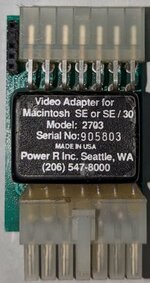Hello!
I acquired a SE/30 in excellent condition. I have had a strong computer background, especially Apple since I was a kid. I am happy to be back into tinkering.
I saw on YouTube that Adrian Black showed how to do a video out from a Macintosh Classic from its analog board through RGB2HDMI. I realized that in the Mac SE and SE/30, the analog board (AB) was designed differently than in the Mac Classic and Classic II. Adrian's video is based on Classic’s AB. The SE and SE/30, as well as older compact Macs, do not have that AB design.
Thank you, @Stephen, for doing this! You did splendidly, and I appreciate that. I want to have the video out from the SE/30 like it was done back in the day to TTL output while I am waiting for @Zane Kaminski and the folks at Garrett's Workshop to come up with a new PDS video card for the SE/30 with a second PDS connector for a network card that I have. I would like to have this output set up.
So, I purchased the Power R Model 2703 Video Adapter for Apple Macintosh SE or SE/30 off eBay. @Stephen, according to Power R's defunct website via the Wayback Machine (scroll down to the bottom of the page), this model has the exact specifications as 2702, only different connectors. Connecting the male end to the SE or SE/30 logic board (LB) and the cable from the female end from LB to the AB is straightforward.
All I have to do is plug-in male to male dupont jumper cables in the black TTL header and solder one end to the RGB female connector as shown in the schematic created by @Stephen. Is that correct? Then, I would get the RGB2HDMI adapter with Pi Zero.
@Stephen can you update your GitHub page to include a clone version for the SE and SE/30 since it needs those types of connectors, as shown in the photo herein? I would be happy to let you know the result after doing this and if the results are favorable?
By the way, thank you, @JDW, so much for your beautiful videos on YouTube! I appreciate your clear explanations and showing the process. Those helped me a LOT to tear down my SE/30.
I acquired a SE/30 in excellent condition. I have had a strong computer background, especially Apple since I was a kid. I am happy to be back into tinkering.
I saw on YouTube that Adrian Black showed how to do a video out from a Macintosh Classic from its analog board through RGB2HDMI. I realized that in the Mac SE and SE/30, the analog board (AB) was designed differently than in the Mac Classic and Classic II. Adrian's video is based on Classic’s AB. The SE and SE/30, as well as older compact Macs, do not have that AB design.
Thank you, @Stephen, for doing this! You did splendidly, and I appreciate that. I want to have the video out from the SE/30 like it was done back in the day to TTL output while I am waiting for @Zane Kaminski and the folks at Garrett's Workshop to come up with a new PDS video card for the SE/30 with a second PDS connector for a network card that I have. I would like to have this output set up.
So, I purchased the Power R Model 2703 Video Adapter for Apple Macintosh SE or SE/30 off eBay. @Stephen, according to Power R's defunct website via the Wayback Machine (scroll down to the bottom of the page), this model has the exact specifications as 2702, only different connectors. Connecting the male end to the SE or SE/30 logic board (LB) and the cable from the female end from LB to the AB is straightforward.
All I have to do is plug-in male to male dupont jumper cables in the black TTL header and solder one end to the RGB female connector as shown in the schematic created by @Stephen. Is that correct? Then, I would get the RGB2HDMI adapter with Pi Zero.
@Stephen can you update your GitHub page to include a clone version for the SE and SE/30 since it needs those types of connectors, as shown in the photo herein? I would be happy to let you know the result after doing this and if the results are favorable?
By the way, thank you, @JDW, so much for your beautiful videos on YouTube! I appreciate your clear explanations and showing the process. Those helped me a LOT to tear down my SE/30.
Last edited:










